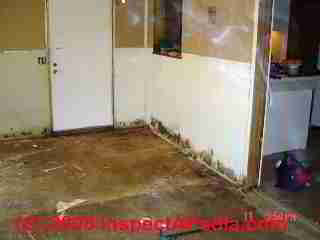Our site offers impartial, unbiased advice without conflicts of interest.
We will block advertisements which we discover or readers inform us are associated with bad business practices,
false-advertising, or junk science. Our contact info is at
High Prices for Home Heating Oil during 2008 and early 2009 Led to Increased Home Leaks
A one-two-three punch of the Great Recession, skyrocketing unemployment, and galloping home heating costs has led many homeowners across the U.S. to turn down the heat in their house.
But in many homes the result of that savings on heating cost has led to an enormous cost to clean up water damage and mold resulting from frozen and burst water piping.
A combination of setting the thermostat lower than ever before, a pipe passing through a cold or drafty building corner, and perhaps homes being empty or even running out of heating oil leads to catastrophe for some homeowners.
In the articles listed below we provide detailed free advice to help building owners avoid these problems.
- HEATING COST FUEL & BTU Cost Table - current cost per 1000 BTUs to heat a building - various fuels
- HEAT LOSS INDICATORS - easy steps to find major points of heat loss in a building
- HEATING COST SAVINGS - how to reduce building heating bills, lots of money-saving suggestions
- WINTERIZE A BUILDING - how to protect a building and its mechanical systems from freeze-damage
- THERMOSTATS - advice on how to use and adjust heating thermostats.
Unsafe Chimneys, Wood Stoves & Auxiliary Heaters Cause More Fires during 2008-2009
CHIMNEY INSPECTION DIAGNOSIS REPAIR - advice on inspecting and repairing chimneys.
Wood Burning Heaters Fireplaces Stoves -important safety advice for these appliances.
Ice Dam Leaks in Buildings Add to Winter Water & Mold Damage
 In addition to the heating and winterizing SNAFU's cited above as sources of increased leaks and mold damage to homes during the winter of 2008 and 2009, a combination of very cold periods of winter weather and inadequate attic ventilation led to formation of ice at building roof edges. Melting snow backs up over the warmer roof surface areas and leaks into the building causing ice dam leaks. See Ice Dams & Attic Condensation & Prevent Ice Dam Leaks in Buildings for an explanation of what causes ice dams and leaks and how they can be prevented. |
Empty Homes Especially at Risk of Leaks, Water Damage, & Mold Damage

The combination of the Great Recession economic collapse, high unemployment, and bank foreclosures has left many homes standing empty during the winter of 2008-2009.
Many empty homes were improperly winterized or were not winterized at all, while at others the fact that the home was unattended meant that the heating system could fail without anyone taking notice.
The result was a higher than usual number of homes suffering leaks and water damage from frozen, then burst water piping.
At the top of this article we listed resources at InspectAPedia.com® that can help homeowners, banks, and other property owners avoid further costly damage to their properties.
InspectAPedia.com is an independent publisher of building, environmental, and forensic inspection, diagnosis, and repair information for the public - we have no business nor financial connection with any manufacturer or service provider discussed at our website.
We are dedicated to making our information as accurate,
complete, useful, and unbiased as possible: we very much welcome critique, questions, or content suggestions for our web articles. Contributors, even if it's just a small correction, are cited, quoted, and linked-to from the appropriate additional web pages and articles - which benefits us both. Working together and exchanging information makes us better informed than any individual can be working alone.
A brief summary about InspectAPedia.com can be read at
-- Daniel Friedman
This Blog is about Home & Building Problems & Building Environmental Problem Diagnosis & Repair. We provide diagnostic field and forensic laboratory investigation services. In depth information is at InspectAPedia.com. Website content suggestions are most welcome. Contact Us.
Building Problem & Environmental Problem Case Histories: Here we post summaries of field investigations of all sorts of building & mechanical system problems. We also post environmental and foernsic lab toxic or allergenic mold and other indoor air quality investigations. We omit private information. We describe observations, procedures, and findings helpful to readers who are trying to remedy their own mold, allergenic, carbon monoxide, odor, or other indoor air and related health concerns in their indoor environment.




